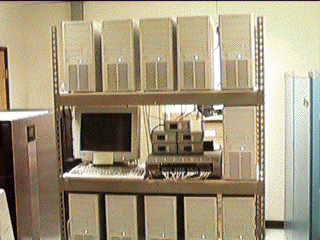Hyglac, a Pile of PCs

Hyglac at JPL

Hyglac at JPL
The Linux operating system (Red Hat distribution) is running on all CPUs, and additional public domain software has been downloaded and installed: MPI (both MPICH and LAM versions), PVM, Gnu compilers (C, C++, g77). Commercial software on order: NAG Fortran 90 compiler and optimized scientific libraries.
Five JPL application codes have been ported to Hyglac, and one additional code port is in progress.
| Code | Description | Results |
|---|---|---|
|
Physical Optics Application |
Used for design of reflector antennas and telescopes operating at microwave frequencies. | Ported successfully. Runs approximately 30% faster than on 16 T3D processors. |
|
Electromagnetic Finite-Difference Time-Domain Application |
Used to solve Maxwell's Equations in the time domain, for analysis of antenna patterns, radar cross section calculations, and examination of fields within small electronic components and interconnects. | Ported successfully. For large problems, runs approximately 2.75 times slower than on 16 T3D processors. |
|
Electromagnetic Finite Element Solver |
Used for similar analysis as the finite difference software. Works in the frequency domain, using a very different algorithm than the FDTD software. | Ported successfully. For large problems, runs approximately 2.9 times slower than on 16 T3D processors. |
|
Incompressible Fluid Flow Application |
Used for solving the Navier-Stokes equations for incompressible flow simulations, using a second-order projection method with a multigrid solver. | Ported successfully. For large problems, runs at approximately the same speed as on 16 T3D processors. |
|
Non-linear Thermal Convection Application |
Used for simulating large scaled three dimensional, time-dependent, thermal convective flows. | Ported successfully. For large problems, runs approximately 1.7 times slower than on 16 T3D processors. |
|
Parallel Extensions for Matlab |
Used to extend Matlab by applying parallel computers to large (time consuming) matrix calculations which can be performed much more quickly in parallel. | Completion of port pending modification to allow PVM visibility of hyglac nodes to the outside world |
Regarding the Hyglac applications:
Daniel S. Katz
Jet Propulsion Laboratory
Daniel.S.Katz@jpl.nasa.gov
(818) 354-7359